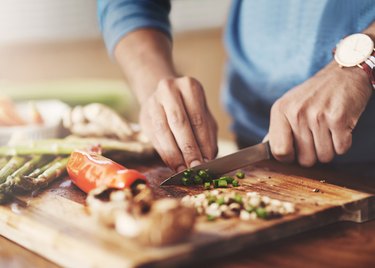
There's a good reason the acronym for the Standard American Diet is (quite literally) SAD. For starters, only 9.3 percent of U.S. adults meet the daily recommended intake for vegetables, per the Centers for Disease Control and Prevention (CDC), with packaged convenience foods consumed far more than fresh, whole foods.
"Many Americans consume large quantities of highly processed refined carbohydrates, sugary foods and drinks and unhealthy fats that are not as nutrient-dense as healthier alternatives," Kristy Del Coro, RDN, a New Jersey-based registered dietitian and culinary nutritionist, tells LIVESTRONG.com.
Video of the Day
Video of the Day
Of course, it's not news that these less-than-perfect diet patterns can contribute to adverse health outcomes, from chronic diseases like heart disease, cancer and obesity. But they're also placing plenty of us in the red zone for critical nutrients.
'Shortfall Nutrients' vs. 'Nutrients of Public Health Concern'
Let's break it down: The USDA includes a list of under-consumed nutrients in the Dietary Guidelines for Americans, a set of national nutritional recommendations that's updated every five years. These under-consumed nutrients, also known as "shortfall nutrients," represent those that are "consumed by many individuals in amounts below the Estimated Average Requirement or Adequate Intake levels," per the 2015-2020 guidelines.
The shortfall nutrients include potassium, dietary fiber, choline, magnesium, calcium and vitamins A, D, E and C. Iron is also considered a shortfall nutrient among women ages 19 to 50, who have higher iron needs than other groups.
While these ten nutrients are under-consumed across the board, only four — calcium, potassium, fiber and vitamin D — are classified as "nutrients of public health concern," since their low intakes are linked to critical health problems, like high blood pressure for low potassium and bone fractures for low vitamin D.
But just because the majority of Americans don't eat enough of these shortfall nutrients doesn't mean we're all suffering from full-blown vitamin deficiencies.
"Being 'short' on a nutrient does not necessarily mean that a person is deficient in that nutrient," explains Jackie Topol, RDN, a New York City-based registered dietitian and culinary nutritionist. "However, consistent inadequate intake may ultimately lead to deficiency."
However, the key to getting adequate amounts of the shortfall nutrients is a fairly simple one. "Eat a varied diet on a regular basis that includes foods from all food groups, especially foods such as fruits and vegetables in a variety of colors as well as whole grains, legumes, healthy fats and protein such as nuts and seeds, eggs and fatty fish," Del Coro tells LIVESTRONG.com. Sounds doable.
To help you out, we're highlighting the ten shortfall nutrients, explaining a few of their primary functions in the body, where they can be found in the diet and tasty ways to get them onto your plate ASAP.
1. Potassium
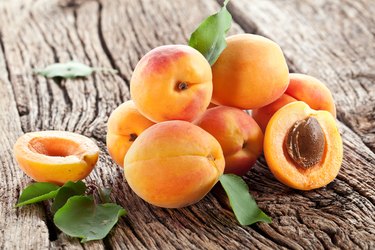
"Potassium is essential for heart health," Del Coro says. "It helps offset the negative effects of sodium, so a lack of potassium can exacerbate high blood pressure." The electrolyte is also involved in muscle contraction. Low potassium levels can result in uncomfortable muscle cramps.
- Dried apricots (½ cup: 1,101 milligrams, 23 percent DV)
- Cooked lentils (1 cup: 731 milligrams, 16 percent DV)
- Prunes (½ cup: 699 milligrams, 15 percent DV)
- Mashed acorn squash (1 cup: 644 milligrams, 14 percent DV)
- Baked potato (1 medium: 610 milligrams, 13 percent DV)
How to get more potassium: "Sautéed beet greens and marinated bean salads or pureed bean dips are easy ways to add more potassium to the diet," Del Coro says. "Adding beans to green or grain salads and snacking on a mix of pistachios, sunflower seeds and dried fruit are also healthy options."
Recipes to Try
- Savory Lentil Chili With Cumin Cream: This hearty vegetarian-friendly chili is loaded with good-for-you vitamins and minerals. You'll get potassium and fiber from the lentils, more potassium and vitamin C in the tomato sauce and additional fiber and magnesium in the cashews and avocado.
- No-Grain Apricot Energy Bar: Almonds and cashews deliver fiber, iron, magnesium and vitamin E while apricots contain potassium and iron. The healthy fats and naturally sweet dried fruit make for the perfect energy-boosting combo.
- Vegetable-Stuffed Acorn Squash: Get your fill of potassium, magnesium and vitamin C from acorn squash, plus iron, potassium, magnesium and vitamins A and C from spinach. Walnuts also offer up some magnesium, iron and fiber.
2. Choline

Choline is best known for its role in brain development and maintaining cognitive health. That's because the nutrient helps produce acetylcholine, a neurotransmitter that's required for memory, muscle function and mood regulation.
"Choline also works to remove cholesterol from the body, so inadequate amounts can lead to a buildup of fat and cholesterol in the liver, which could result in liver damage," Del Coro says.
- Hard-boiled eggs (1 large egg: 147 milligrams, 27 percent DV)
- Roasted soybeans (½ cup: 107 milligrams, 19 percent DV)
- Lean ground beef (3 ounces: 72 milligrams, 13 percent DV)
- Roasted chicken breast (3 ounces: 72 milligrams, 13 percent DV)
- Cooked Atlantic cod (3 ounces: 71 milligrams, 13 percent DV)
How to get more choline: Despite all the debate surrounding eggs, most experts agree that they're beneficial for your health. "Incorporate eggs into the diet regularly," says Del Coro.
Stirring peanut butter into your morning oatmeal and tossing roasted soybeans onto your salad for some crunch are easy ways to up your choline intake as well.
Recipes to Try
- Roasted Chicken Salad With Almonds and Cherries: This recipe offers iron and choline from the chicken, vitamin E and magnesium from the almonds and calcium from the yogurt.
- L.A. Avocado Toast With Hard-Boiled Egg: You'll get choline, vitamin D and vitamin A from the eggs, plus magnesium, potassium and fiber from the avocado.
- Ground Beef Tacos With Crispy Cheese Shells: Find calcium in the cheese, iron in the beef, potassium in the tomatoes and vitamin C in the onions, tomatoes and bell peppers.
3. Magnesium
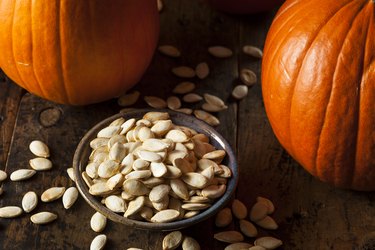
The mineral has been found to play a role in countless functions in the body, from protein synthesis and blood sugar control to energy production, stress regulation and digestive health.
In a November 2019 review published in the journal Diabetes Metabolism Research and Reviews, data pooled from studies involving 35 different cohorts showed the highest magnesium intake was associated with a 22-percent lower risk of type 2 diabetes compared to the lowest magnesium intake. Magnesium supplementation was also shown to decrease participants' fasting blood sugar and triglyceride levels, as well as insulin resistance.
- Pumpkin seeds (¼ cup: 37 percent DV)
- Dry roasted almonds (1 ounce: 80 milligrams, 20 percent DV)
- Boiled spinach (½ cup: 78 milligrams, 20 percent DV)
- Dry roasted cashews (1 ounce: 74 milligrams, 19 percent DV)
- Cooked black beans (½ cup: 60 milligrams, 15 percent DV)
How to get more magnesium: "Pumpkin seeds have the highest amount of magnesium out of all the seeds," says Topol. "Snack on toasted pumpkin seeds for a midday snack or add beans or lentils to your salads."
For a healthy hit of multiple shortfall nutrients, top your morning yogurt bowl with a mixture of nuts and seeds, along with sliced banana and chopped dates. You'll get magnesium from the nuts and seeds, potassium from the bananas and dates and calcium from the yogurt.
Recipes to Try
- Creamy Vegan Spinach: Get a healthy dose of iron from the spinach as well as vitamin E from the olive oil.
- Breakfast Nachos With Sweet Potato Waffle Fries, Black Beans, Shiitake Bacon and Eggs: You’ll get your fair share of shortfall nutrients from this breakfast of champions that includes beta-carotene and potassium in the sweet potatoes, magnesium and fiber in the black beans and avocado and vitamin D in the eggs.
- Peanut Butter Protein Pancakes: Find fiber, iron and magnesium in the oats, potassium in the banana, and calcium in the cottage cheese in these fluffy protein-packed pancakes.
4. Fiber
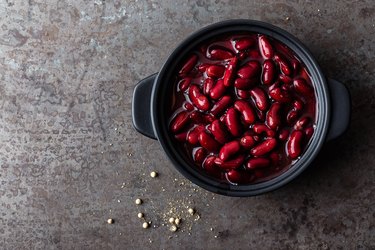
Fiber is kind of a big deal, in large part because the nondigestible carbohydrate carries out countless functions in the body, from promoting weight loss to helping lower your blood sugar and cholesterol levels.
Fiber also does good for your gut microbiome, the collection of bacteria that lives in your GI tract and has been linked to immune health, mood disorders and more.
- Kidney beans (1 cup: 12 grams, 50 percent DV)
- Raspberries (¾ cup: 18 grams, 64 percent DV)
- Chia seeds (1 ounce: 11 grams, 42 percent DV)
- Artichoke hearts (1 cup: 9.5 grams, 38 percent DV)
- Cooked brown rice (1 cup: 4 grams, 16 percent DV)
How to get more fiber: Fortunately, it's actually pretty simple. Eat more plants and you'll automatically up your fiber intake. Whole grains, fruits, vegetables, pulses, nuts and seeds are all fabulous sources of fiber.
For a fiber-filled start to your day, make overnight oats with raspberries, chia seeds and your preferred milk and yogurt, Topol suggests. "It will keep you full and energized for hours." Later on, swap standard pasta for bean- or lentil-based noodles at lunch or dinner. Legume pastas offer a higher fiber content, plus an extra hit of plant-based protein.
Recipes to Try
- Lentil Pasta With Creamy Red Pepper Sauce and Spinach: This vegan-friendly dish is packed with multiple shortfall nutrients. You’ll get fiber from the lentil pasta and white beans, vitamin C from the red bell pepper and magnesium and vitamins A and E from the spinach.
- Chocolate Chia Pudding: Almond butter packs vitamin E while chia seeds contain soluble fiber, calcium, magnesium and iron.
- Vegan Black Bean Sandwich With Slaw: Cabbage is a great source of vitamin C while black beans offer up iron, potassium, fiber and magnesium.
5. Calcium
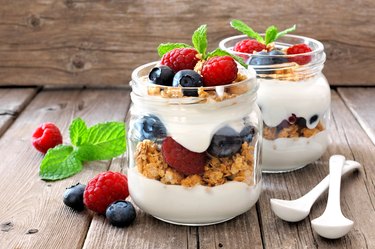
The most prevalent mineral in the body, calcium is involved in everything from muscle contraction and nerve function to hormone signaling. "Calcium is also essential for bone health," Del Coro says. "An inadequate intake can lead to increased risk of bone fracture."
- Plain low-fat yogurt (8 ounces: 415 milligrams, 32 percent DV)
- Part-skim mozzarella cheese (1.5 ounces: 333 milligrams, 26 percent DV)
- Canned sardines in oil (3 ounces: 325 milligrams, 25 percent DV)
- Firm tofu made with calcium sulfate (½ cup: 253 milligrams, 19 percent DV)
- Cooked kale (1 cup: 94 milligrams, 7 percent DV)
How to get more calcium: "Dairy, fortified tofu, some fortified nut milks, fortified orange juice, white beans, kale, broccoli, bok choy, cabbage, mustard and turnip greens are all sources of calcium," Del Coro says.
Recipes to Try
- Healthy Fruit and Yogurt Smoothie: Snag some calcium from the milk and yogurt plus fiber and vitamin C from the berries.
- Seaweed Tofu Wrap: Cabbage is full of vitamin C while fortified tofu contains iron and calcium.
- Crunchy Kale Salad: This superfood salad offers fiber from apples, calcium and vitamin C from kale and vitamin E from the sunflower seeds.
6. Vitamin A
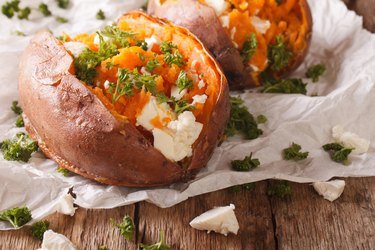
"True vitamin A deficiencies are rare in the U.S., but they can lead to a variety of issues across multiple health systems, including vision problems, poor growth, poor wound healing and infertility," Del Coro says.
Provitamin A carotenoids, such as beta-carotene, are a form of vitamin A found in plants. They essentially act as precursors to vitamin A production in the body. Preformed vitamin A is the form found in animal products like dairy and meat.
- Baked sweet potato (1 potato: 1,403 micrograms retinol activity equivalents [RAE], 156 percent DV)
- Boiled spinach (½ cup: 573 micrograms RAE, 64 percent DV)
- Raw carrots ( ½ cup: 459 micrograms RAE, 51 percent DV)
- Cantaloupe (½ cup: 135 micrograms RAE, 15 percent DV)
- Red peppers (½ cup: 117 micrograms RAE, 13 percent DV)
How to get more vitamin A: Vitamin A is a fat-soluble vitamin, which means that pairing vitamin A-rich foods with a healthy source of fat enhances the nutrient's absorption in the body. For this reason, Del Coro recommends roasting vitamin A-containing root veggies (think: sweet potatoes and carrots) with a heart-healthy oil such as olive oil.
Sautéing dark leafy greens with minced garlic and oil is another great option. Plus, it's easier — and more enjoyable — to eat more of the green stuff once it's cooked down and softer in texture.
Recipes to Try
- Sweet Potato Nachos: Consider these nachos the shortfall nutrient jackpot. There's beta-carotene in the sweet potatoes, fiber and iron in the black beans, magnesium in the avocado, calcium in the cheese and potassium and vitamin C in the tomatoes.
- Carrot Cake Pancakes: Find beta-carotene in the shredded carrots and choline and vitamin D in the eggs. Apple sauce and raisins will also serve up a bit of fiber.
- Broccoli Hash With Eggs: This recipe packs fiber, beta-carotene, vitamin C and calcium in the broccoli, as well as vitamin D and choline in the eggs.
7. Vitamin D
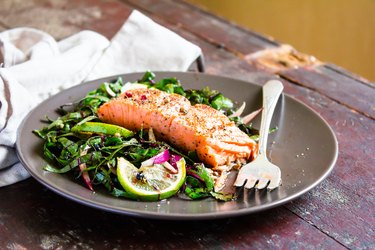
Like all the shortfall nutrients, vitamin D plays a pretty important role in our overall health. A few of its main jobs include helping to facilitate the absorption of calcium in the GI tract and promoting bone health, immune function and cell growth.
Vitamin D deficiency has also been associated with varied conditions, from preeclampsia to autoimmune disorders and neurological abnormalities, per a May 2017 review in the journal Reviews in Endocrine & Metabolic Disorders.
- Cod liver oil (1 tablespoon: 1,360 IUs, 340 percent DV)
- Swordfish (3 ounces: 566 IUs, 142 percent DV)
- Sockeye salmon (3 ounces: 447 IUs, 112 percent DV)
- Fortified yogurt (6 ounces: 80 IUs, 20 percent DV)
- Eggs (1 large: 41 IUs, 10 percent DV)
How to get more vitamin D: Few foods naturally contain vitamin D, which is why household staples like orange juice, milk and yogurt are often fortified with the nutrient. Even so, "fortified food products really do not provide sufficient amounts of vitamin D," Topol says. "Our best source is the sun." More specifically, it's the exposure to sunlight that allows our bodies to convert the precursor (calcitriol) to active vitamin D.
"I strongly advise people living in colder climates to have their vitamin D level checked," Topol says. "From my experience working in New York, many people showed deficiency when their level was checked." If tests show that you are deficient in vitamin D, consider talking to your doctor or a registered dietitian about the appropriateness of supplementation.
To up your vitamin D intake via the diet, aim to put more fatty fish on your plate. "Try making homemade salmon burgers or add canned white tuna to a salad," Topol suggests. "Just be sure to keep tuna consumption to less than two to three times per week due to high mercury levels."
Recipes to Try
- Simple Dijon Salmon: You'll get a healthy dose of D from the oily salmon.
- Matchaccino Yogurt Shake: Yogurt naturally contains calcium and many varieties are also fortified with vitamin D.
- Southwestern Egg Scramble: This recipe serves up choline and vitamin D from the eggs and magnesium, fiber and potassium from both the black beans and avocado.
8. Vitamin E
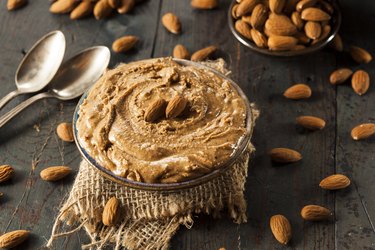
Vitamin E is best known for its antioxidant properties. The nutrient helps reduce free radical damage in the body, which is linked to chronic inflammation and conditions like heart disease and cancer. According to Del Coro, true vitamin E deficiencies are rare in the U.S., but can lead to neurological issues and muscle pain.
- Wheat germ oil (1 tbsp: 20.3 milligrams, 135 percent DV)
- Sunflower seeds (1 ounce: 7.4 milligrams, 49 percent DV)
- Almonds (1 ounce: 6.8 milligrams, 45 percent DV)
- Sunflower oil (1 tbsp: 5.6 milligrams, 37 percent DV)
- Peanut butter (2 tbsp: 2.9 milligrams, 19 percent DV)
How to get more vitamin E: "Incorporate vitamin E-rich oils into your cooking or use them in dressings for your salads and grain bowls," Del Coro recommends.
"You can also add nuts and seeds to your meals or simply eat them as snacks." Since vitamin E is also found in foods like avocado and dark leafy greens, Del Coro suggests wilting veggies like beet and turnip greens, spinach or Swiss chard and adding them into frittatas, soups and stews.
Recipes to Try
- Almond Butter-Stuffed Dates: This recipe contains potassium and magnesium from the dates, as well as magnesium and vitamin E in the almond butter.
- Sunflower Seed and Sage Crusted Chicken Tenders: You'll find iron in the chicken, plus vitamin E in the sunflower seeds.
- Cold Peanut Butter “Noodles”: Get a hit of vitamin A from the carrot "noodles" in addition to vitamin E from the peanut butter.
9. Vitamin C

Since the body cannot produce vitamin C, it's essential to get the water-soluble vitamin via the diet. While vitamin C is most often recognized for its role in immune health, the antioxidant is also required for the metabolism of proteins, iron absorption and the synthesis of collagen in the skin.
- Red bell pepper (½ cup: 95 milligrams, 106 percent DV)
- Orange (1 medium: 70 milligrams, 78 percent DV)
- Kiwi (1 medium: 64 milligrams, 71 percent DV)
- Broccoli (½ cup: 51 milligrams, 57 percent DV)
- Cauliflower (½ cup: 26 milligrams, 29 percent DV)
How to get more vitamin C: The good news is that vitamin C is in plenty of foods — and most of them are staples you probably already eat.
"Snack on cut-up bell peppers dipped into hummus, make a delicious smoothie with kale, frozen strawberries, frozen pineapple and soy milk, or roast broccoli or Brussels sprouts with a little olive oil and Trader Joe's Everything But The Bagel seasoning," Topol suggests. Don't mind if we do.
Recipes to Try
- Cauliflower Pancakes: This recipe provides choline and vitamin D thanks to the eggs, as well as vitamin C, potassium and magnesium in the cauliflower. Bonus points for a hit of calcium from the ricotta cheese.
- Orange-Kissed Vanilla Shake: This simple smoothie brings 10 grams of dietary fiber per serving. You’ll also get vitamin C from the orange, calcium and potassium from the Greek yogurt and fiber from the chia seeds.
- Orange Chicken and Cauliflower Rice: Find iron in the chicken, vitamin C in the orange juice and potassium and magnesium in the cauliflower rice.
10. Iron
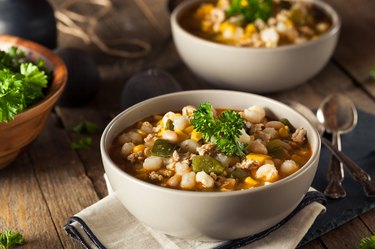
Iron's main function is to help transport oxygen throughout the body. It does this via hemoglobin, a protein found in red blood cells that shuttles oxygen from the lungs to the rest of the body.
There are two types of iron: Heme iron, which is more readily absorbed by the body, and non-heme iron. Non-heme iron is found in plant sources of iron, as well as iron-fortified foods. Animal sources of iron contain both heme and non-heme iron.
- Fortified cereals (1 serving: 18 milligrams, 100 percent DV)
- White beans (1 cup: 8 milligrams, 44 percent DV)
- Oysters (3 ounces: 8 milligrams, 44 percent DV)
- Dark chocolate, 45-69 percent cocoa (3 ounces: 7 milligrams, 39 percent DV)
- Tofu (½ cup: 3 milligrams, 17percent DV)
How to get more iron: "People always think of animal protein first when they think of iron, but there are plant-based options as well," Topol tells LIVESTRONG.com. "To add more iron to your diet, whip up your own hummus, cook a simple lentil soup, make a yummy sandwich with baked tofu, avocado and veggies or cook in cast iron, which naturally adds iron to your food."
Tip
If you’re eating a plant-based source of iron, be sure to pair it with a food that’s high in vitamin C (such as red bell peppers and citrus), which helps enhance the body’s absorption of non-heme iron.
Recipes to Try
- Veggie Tofu Scramble: There's iron in the tofu, plus vitamins A, E and C in the bell peppers. Double win.
- One-Pot Penne With Cauliflower and White Beans: You'll get fiber and iron from the white beans and potassium, magnesium and vitamin C from the cauliflower.
- Dark Chocolate Strawberry Fries: We love that this good-for-you dessert serves up magnesium and iron from the dark chocolate, vitamin C and fiber from the strawberries and beta-carotene and potassium from the sweet potatoes. It’s basically the shortfall nutrient jackpot and tastes like a total treat.
Foods That Contain Two or More Shortfall Nutrients
Many common kitchen staples contain multiple shortfall nutrients, which is good news when you're trying to up your intake. Some of these foods include:
- Eggs: One whole egg packs about 27 percent of your DV for choline and 5 percent DV for vitamin D.
- Broccoli: One cup contains about 3 percent DV of fiber, 3 percent DV of calcium, 3 percent DV of vitamin A and an impressive 90 percent DV of vitamin C.
- Peanuts: Just 1 ounce packs 10 percent DV of fiber, 3 percent DV of choline, 11 percent DV of magnesium and 16 percent DV of vitamin E.
- Avocado: One cup of avocado has 40 percent DV of fiber, 10 percent DV of magnesium and 15 percent DV of potassium.
- Plain yogurt: A one-cup serving has 8 percent DV of potassium and 23 percent DV of calcium.
- U.S. Department of Health & Human Services: “Facts & Statistics on Physical Activity, Nutrition & Obesity”
- Centers for Disease Control and Prevention: “Data & Statistics”
- U.S. Departure of Agriculture: “2015-2020 Dietary Guidelines for Americans”
- Academy of Nutrition & Dietetics: “Foods to Fight Iron Deficiency”
- Diabetes Metabolism Research and Reviews: “Association of Magnesium Consumption With Type 2 Diabetes and Glucose Metabolism: A Systematic Review and Pooled Study With Trial Sequential Analysis”
- Reviews in Endocrine and Metabolic Disorders: “The Vitamin D Deficiency Pandemic: Approaches for Diagnosis, Treatment and Prevention”
- MyFoodData: "Pumpkin and Squash Seeds"
- National Institutes of Health: "Potassium"
- National Institutes of Health: "Choline"
- National Institutes of Health: "Magnesium"
- National Institutes of Health: "Calcium"
- National Institutes of Health: "Vitamin A"
- National Institutes of Health: "Vitamin D"
- National Institutes of Health: "Vitamin E"
- National Institutes of Health: "Vitamin C"
- National Institutes of Health: "Iron"
- MyFoodData: "Eggs"
- MyFoodData: "Broccoli"
- MyFoodData: "Peanuts"
- MyFoodData: "Avocados"
- MyFoodData: "Plain Yogurt"
- MyFoodData: "Brown Rice"
- MyFoodData: "Raspberries"
- MyFoodData: "Chia Seeds"
- MyFoodData: "Artichoke"
- MyFoodData: "Kidney Beans"